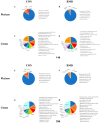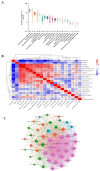Dietary Bacitracin Methylene Disalicylate Improves Growth Performance by Mediating the Gut Microbiota in Broilers
- PMID: 35740224
- PMCID: PMC9219630
- DOI: 10.3390/antibiotics11060818
Dietary Bacitracin Methylene Disalicylate Improves Growth Performance by Mediating the Gut Microbiota in Broilers
Abstract
The growth performance of livestock and poultry has always been a concern. However, much work is currently focused on the selection of breeds and diets to improve the growth performance of livestock and poultry. Furthermore, numerous studies have shown that the gut microbiota is closely related to the growth performance of livestock and poultry. At present, there are many reports on the impact of antibiotic intervention on the structure of gut microbiota. However, there are few reports on the influence of antibiotic intervention on the structure of intestinal microbes and the effect of this change on growth performance. Bacitracin methylene disalicylate (BMD) intervention changes the microbial structure in the caecum of broilers at different growth stages, as shown in this study. To further reveal the potential relationship between gut microbiota changes and growth performance caused by BMD intervention, correlation analysis was used for analysis. A total of 144 1-day-old male Cobb-Vantress were randomly divided into two groups. In addition to antibiotic-free starter mash diets, starter mash diets supplemented with 55 mg/kg BMD were also used, called the CON group and the BMD group, and lasted 28 days. (1) These study results showed that adding BMD to the diet had a significant effect on the growth performance of broilers. Compared with the CON group, the body weight of the BMD group increased significantly by 11.08% and 20.13% on Days 14 and 28, respectively (p < 0.05). Similarly, at 0−14, 14−28 and 0−28 days of age, the average daily gain of the BMD group increased significantly by 12.28%, 24.49% and 20.80%, respectively. The average daily feed intake of the BMD group increased significantly by 18.28%, 27.39% and 24.97% (p < 0.05). In addition, at 0−28 days of age, the feed conversion ratio increased significantly by 5.5% (p < 0.05). (2) Alpha diversity results show that BMD intervention has an impact on gut microbiota at different growth stages. (3) The early intervention significantly affected 7 taxa by Day 14, followed by 22 taxa by Day 28, which is similar to the results in the caecal flora. Compared with the CON group, the Christensenellaceae R-7 group had the highest linear discriminant analysis (LDA) score on Day 28. In addition, Pearson’s correlation analysis showed that the Lachnospiraceae FCS020 group was significantly negatively correlated with growth performance. In general, these results indicate that dietary supplementation of BMD has an effect on broiler gut microbiota structure and growth performance. However, changes in growth performance may be caused by the gut microbiota structure.
Keywords: bacitracin methylene disalicylate; broilers; growth performance; gut microbiota.
Conflict of interest statement
The authors declare no conflict of interest.
Figures








Similar articles
-
Gut Microbiota Dynamics, Growth Performance, and Gut Morphology in Broiler Chickens Fed Diets Varying in Energy Density with or without Bacitracin Methylene Disalicylate (BMD).Microorganisms. 2021 Apr 9;9(4):787. doi: 10.3390/microorganisms9040787. Microorganisms. 2021. PMID: 33918770 Free PMC article.
-
Effect of dietary Saccharomyces-derived prebiotic refined functional carbohydrates as antibiotic alternative on growth performance and intestinal health of broiler chickens reared in a commercial farm.Poult Sci. 2023 Jun;102(6):102671. doi: 10.1016/j.psj.2023.102671. Epub 2023 Mar 24. Poult Sci. 2023. PMID: 37120891 Free PMC article.
-
Efficacy of Bacillus subtilis and bacitracin methylene disalicylate on growth performance, digestibility, blood metabolites, immunity, and intestinal microbiota after intramuscular inoculation with Escherichia coli in broilers.Poult Sci. 2017 May 1;96(5):1174-1183. doi: 10.3382/ps/pew347. Poult Sci. 2017. PMID: 28339520
-
Use of Bacillus Subtilis PB6 as a potential antibiotic growth promoter replacement in improving performance of broiler birds.Poult Sci. 2017 Aug 1;96(8):2614-2622. doi: 10.3382/ps/pex079. Poult Sci. 2017. PMID: 28482065
-
Comparative efficacy of spray-dried plasma and bacitracin methylene disalicylate in reducing cecal colonization by Salmonella Enteritidis in broiler chickens.Poult Sci. 2021 Jul;100(7):101134. doi: 10.1016/j.psj.2021.101134. Epub 2021 Mar 15. Poult Sci. 2021. PMID: 34089939 Free PMC article.
Cited by
-
Effect of areca nut extracts on growth performance, slaughtering performance, and meat quality of broiler chickens.Front Vet Sci. 2025 Apr 28;12:1579415. doi: 10.3389/fvets.2025.1579415. eCollection 2025. Front Vet Sci. 2025. PMID: 40357195 Free PMC article.
-
Bacitracin Methylene Disalicylate (BMD) Treatment Affects Spleen Proteome in Broiler Chicks Infected with Salmonella enteritidis.Antibiotics (Basel). 2024 May 1;13(5):414. doi: 10.3390/antibiotics13050414. Antibiotics (Basel). 2024. PMID: 38786142 Free PMC article.
-
Response of YPM x Ross 708 male broilers to diets containing varying inclusions of phytase, calcium butyrate, and bacitracin methylene disalicylate during the grower and finisher periods-part 2: Intestinal health and physiology.Poult Sci. 2025 Mar;104(3):104862. doi: 10.1016/j.psj.2025.104862. Epub 2025 Jan 31. Poult Sci. 2025. PMID: 39923452 Free PMC article.
-
Influence of phytochemicals on growth performance, gut morphology and ceca microbiome in broilers fed aflatoxin-contaminated diet and raised under high stocking density and heat stress.Poult Sci. 2025 Aug;104(8):105293. doi: 10.1016/j.psj.2025.105293. Epub 2025 May 15. Poult Sci. 2025. PMID: 40424880 Free PMC article.
-
An evaluation of the thermoregulatory potential of in ovo delivered bioactive substances (probiotic, folic acid, and essential oil) in broiler chickens.Poult Sci. 2023 May;102(5):102602. doi: 10.1016/j.psj.2023.102602. Epub 2023 Feb 18. Poult Sci. 2023. PMID: 36924590 Free PMC article.
References
-
- Park I., Lee Y., Goo D., Zimmerman N.P., Smith A.H., Rehberger T., Lillehoj H.S. The effects of dietary Bacillus subtilis supplementation, as an alternative to antibiotics, on growth performance, intestinal immunity, and epithelial barrier integrity in broiler chickens infected with Eimeria maxima. Poult. Sci. 2020;99:725–733. doi: 10.1016/j.psj.2019.12.002. - DOI - PMC - PubMed
-
- Binversie E.S., Ruegg P.L., Combs D.K., Ollivett T.L. Randomized clinical trial to assess the effect of antibiotic therapy on health and growth of preweaned dairy calves diagnosed with respiratory disease using respiratory scoring and lung ultrasound. J. Dairy Sci. 2020;103:11723–11735. doi: 10.3168/jds.2019-18044. - DOI - PubMed
LinkOut - more resources
Full Text Sources

